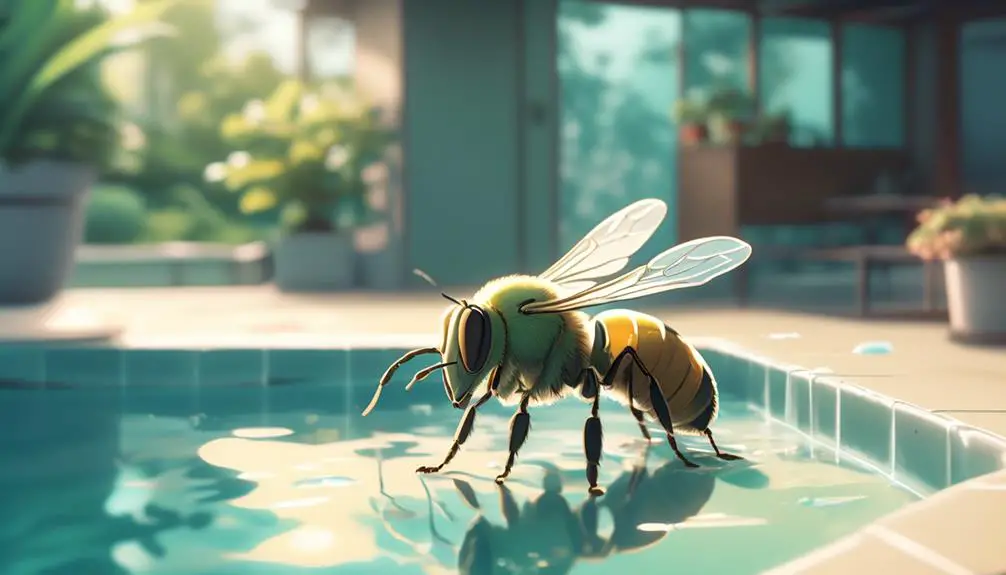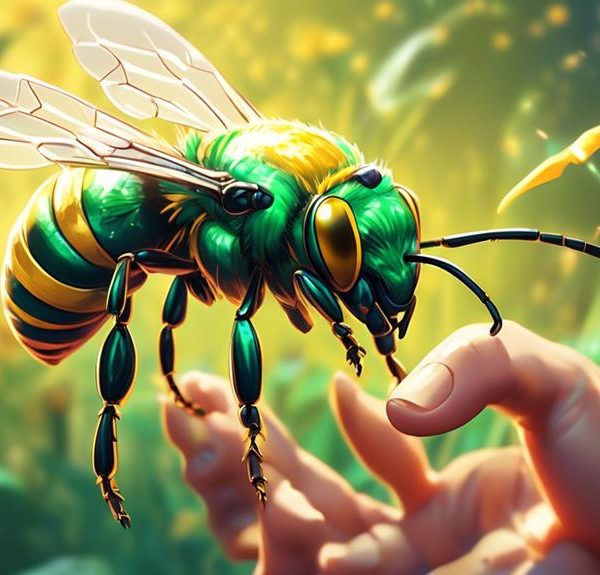Dive into your bee-free pool this summer, as we unravel effective strategies to deter sweat bees, starting with understanding their behavior.

How to Get Rid of Sweat Bees in a Swimming Pool
Whether you're enjoying a refreshing dip on a hot day, hosting a lively pool party, or just lounging by the water's edge, sweat bees can be an unwelcome guest. These small, often iridescent insects are attracted to your pool for a variety of reasons, from the water's moisture to the sweet scent of your sunscreen.
You're here because you've had enough of sharing your relaxation time with these pesky intruders, and you're ready to reclaim your oasis. Well, you're in luck. We're about to explore a range of effective strategies to keep these buzzing bugs at bay, but it's not just about getting rid of them.
Believe it or not, the secret lies more in understanding them.
Key Takeaways
- Sweat bees are attracted to pools because of the salt and moisture around them.
- Prevention strategies for sweat bees include keeping food and drinks sealed, maintaining a clean pool environment, covering the pool when not in use, and using natural repellents.
- Effective sweat bee removal techniques include hiring professional pest control services, using DIY traps with sweet liquid, spraying insecticidal soaps, and using bug zappers.
- To maintain a bee-free swimming pool, regularly clean the pool, check and maintain the chemical balance, and cover the pool when not in use.
Understanding Sweat Bees

Before you tackle the task of eradicating sweat bees from your pool, it's important to grasp a clear understanding of these unique insects. Sweat bees, scientifically classified as 'Halictidae,' are small, typically metallic-colored bees that often get attracted to human perspiration. They're known to be less aggressive than other bee species, but they can sting if threatened or stepped on.
They are quite beneficial for the environment as they pollinate a variety of plants. However, their attraction to salt in human sweat can make them a nuisance, especially when you're trying to enjoy a relaxing swim. You'll often find them buzzing around pool areas because the water and swimmers provide a great source of salt.
To effectively manage a sweat bee problem, you need to understand their behavior and life cycle. These insects nest in the ground and are most active during the warm months of the year. They're social creatures that live in colonies, with the queen bee laying eggs in the nest. Knowing this helps you strategize the best timing and methods for control. Remember, your objective isn't to harm these beneficial insects but to discourage them from your pool area.
Why Sweat Bees Love Pools

Having understood the behavior and life cycle of sweat bees, it's crucial to explore why they're particularly drawn to swimming pools. Sweat bees, as their name suggests, are attracted to human sweat, which is abundant around pools. They're not just after the salt in your sweat, but also the moisture it provides.
Here's a table that explains why sweat bees find swimming pools irresistible:
Attraction | Explanation | Impact |
|---|---|---|
Salt | Sweat bees need salt for their physiological functions. | They're attracted to your sweat and the pool water. |
Moisture | They require moisture for survival and reproduction. | Pools provide an abundant source of water. |
Nesting Ground | They often nest in damp soil near water sources. | The soil around your pool might be a perfect home for them. |
Prevention Strategies for Sweat Bees

To keep sweat bees at bay, it's essential to implement effective prevention strategies that disrupt their attraction to your pool area.
The first step is to reduce their food source. Since sweat bees are attracted to sweet substances, ensure that food and drinks are kept sealed and away from the pool.
Next, you must maintain a clean pool environment. Regularly skim and vacuum your pool to remove potential bee attractions like pollen and insects. Cover your pool when not in use to deter sweat bees from gathering.
Another strategy involves the use of natural repellents like essential oils. Citronella, eucalyptus, and peppermint oils can deter sweat bees. Mix these oils with water and spray around the pool area regularly.
Lastly, consider professional pest control if the infestation is severe. They'll use safe and efficient methods to manage the sweat bees around your pool.
Effective Sweat Bee Removal Techniques

Even though prevention is key, there may be times when you'll need to resort to effective sweat bee removal techniques to manage a persistent infestation in your pool area.
Firstly, consider professional pest control services. They're trained to deal with such infestations and can ensure a thorough job while minimizing the risks involved.
However, if you're inclined to a DIY approach, traps are your best bet. Fill a jar with a sweet liquid, such as soda or syrup, cover it with plastic wrap, and make small holes. The bees will be attracted to the sweetness, enter the jar, and won't be able to escape.
Insecticidal soaps are another option. These are safe for you and the environment, yet lethal for the sweat bees. Spray it directly onto the bees or their nesting areas. Remember, it's important to wear protective gear to guard against any potential stings.
Lastly, you can use bug zappers. These devices lure in sweat bees with light and then electrocute them. Place it near the pool, but not too close to avoid unwanted shocks.
Maintaining a Bee-Free Swimming Pool

After implementing these effective sweat bee removal techniques, it's crucial to maintain a consistent routine to ensure your swimming pool remains bee-free. Regular pool cleaning is key. Remove any debris, such as fallen leaves and flowers, that might attract bees.
You should also regularly check the pool's chemical balance. An unbalanced pool can attract a variety of pests, including sweat bees. Ensure your pool's pH level stays between 7.2 and 7.8.
Below is a table summarizing these preventive measures:
Action | Description |
|---|---|
Regular Cleaning | Remove debris like leaves and flowers that attract bees. |
Check Chemical Balance | Keep pool pH between 7.2 and 7.8 to deter pests. |
Lastly, cover your pool when not in use. A pool cover prevents sweat bees from accessing the water and discourages them from making your pool their regular stop.
Conclusion
In conclusion, understanding sweat bees and their attraction to pools is key in managing them.
By implementing prevention strategies and effective removal techniques, you can significantly reduce their presence.
Remember, maintaining a bee-free pool isn't just about removing existing bees, but about creating an environment where they're less likely to return.
Stay vigilant, and you'll enjoy a refreshing, bee-free dip in no time.


